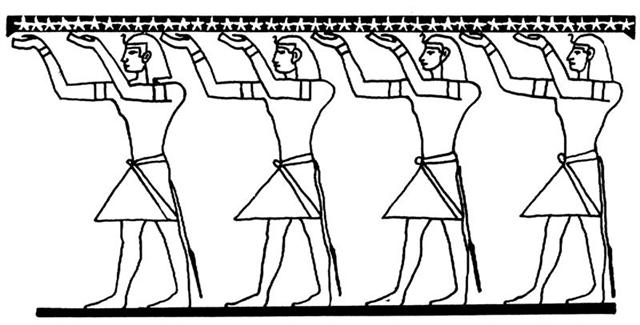Counting 6 glyphs ('years')
ahead from Alnitak (ζ)
leads to the Milky Way barrier as defined by
Praja-pāti (Lord of Created Beings, δ
Aurigae):
|
Khufu |
Khafre |
|
Menkaure |
- |
 |
 |
 |
 |
|
Ga1-18 |
Ga1-19 |
Ga1-20 |
Ga1-21 |
|
Mintaka
(82.4), χ Aurigae (82.5), ε Columbae
(82.6) |
Al Hak'ah-3 /
Mrigashīrsha-5 /
Turtle-20 |
Three Stars-21 /
ANA-IVA (7) |
ο Aurigae (85.8), γ Leporis (85.9)
Yang Mun
|
|
Arneb,
Crab
Nebula
(83.0,
φ╣ Orionis
(83.1),
HEKA
(83.2), Hatysa, M36 (83.5),
φ▓ Orionis
(83.6),
Alnilam
(83.7) |
Heavenly Gate, ν Columbae (84.0),
ALNITAK,
PHAKT
(Phaet) (84.7) |
|
June 11 |
12 |
June 13 (530) |
14 (165) |
|
║June 7 (156 / 2 = *78) |
8 |
║June 9
(160) |
10 (*81) |
|
'May 15 |
16 (136) |
'May 17 (137) |
18 (*58) |
|
"May 1 |
2 (122) |
"May 3 (*43) |
4 (490) |
|
Alwaid,
Maasym (265.1),
Shaula
(265.3), Kuma
(265.6), σ Arae (265.9)
Hamal
|
Ras
Alhague (266.1),
Sargas
(266.3), μ Ophiuchi, π Arae (266.5),
Nan Hae (266.6), ι Herculis (266.7) |
λ Arae
(267.1),
Girtab, ο Serpentis (267.6) |
Kelb
Alrai, μ Arae (268.1), Kew Ho
(268.6), η Pavonis (268.7),
Apollyon
(268.9) |
|
11
(*265) |
12 (346) |
December 13 (713) |
14 (*268) |
|
7 |
8 (342) |
║December 9 (709) |
10 (344) |
|
14 (318) |
15 |
'November 16 (*240) |
17 (321) |
|
31 (*590) |
"November 1 |
"November 2 (*226) |
3 (307) |
 |
 |
 |
 |
 |
|
Ga1-22 |
Ga1-23 |
Ga1-24 |
Ga1-25 |
Ga1-26 |
|
μ Columbae (86.1), Saiph
(86.5), τ Aurigae, ζ Leporis
(86.6) |
υ Aurigae (87.1), ν Aurigae
(87.2), Wezn, M37 (87.6), δ
Leporis (87.7), Tze (87.9) |
Ardra-6 /
ANA-VARU (8) |
η Leporis (89.0),
Praja-pāti, Menkalinan,
Mahashim, and γ Columbae
(89.3), π Aurigae (89.4), η
Columbae (89.7) |
μ Orionis (90.3), χ▓ Orionis
(90.5) |
|
ξ Aurigae (88.1),
BETELGEUZE
(88.3), ξ Columbae (88.5), σ
Columbae (88.7)
Zuben Elgenubi
|
|
June 15 |
16 |
17 (168) |
18 |
19 (*90) |
|
║June 11 |
12 |
13 (164) |
14 (*85) |
15 |
|
'May 19 |
20 (140) |
21 |
22 |
23 (*63) |
|
"May 5 |
6 (126) |
7 |
8 |
9 (*49) |
|
Muliphen (269.0), Basanismus
(269.5), Pherkard (269.9) |
Ptolemy Cluster (270.5) |
Rukbalgethi Genubi (271.1), ξ
Herculis (271.5), Etamin, ν
Herculis (271.7), ν Ophiuchi
(271.8) |
ζ
Serpentis (272.4), τ Ophiuchi
(272.9) |
Winnowing Basket-7 |
|
18h (273.4) |
|
NASH
(273.7), θ Arae (273.8) |
|
December 15 |
16 (350) |
17 |
18 |
19 (*273) |
|
║December 11 |
12 (*266) |
13 |
14 (348) |
15 |
|
'November 18 |
19 |
20 (324) |
21 |
22 (*246) |
|
"November 4 |
5 (*229) |
6 (310) |
7 |
8 |
The last star of Orion is
Betelgeuze.
|
ORION: |
|
5 |
Mrigashīrsha |
λ, φ╣, and φ▓ Orionis |
Stag's head |
83 = 68
+ 15 |
|
the deer's head |
Heka |
June 12 (163) |
|
6 |
Ardra |
α Orionis |
Teardrop, diamond, a human
head |
88 = 83
+ 5 |
|
the moist one |
Betelgeuze |
June 17 (168 |
The Polynesian word
varu (8) - as in Ana-varu
(8th star) - could be related to
varua (spirit):
|
Varu
1. To
cut one's hair (te
puoko). 2. To shave.
3. To paint, to put on
make-up: he varu te
kiea. Varu a-roto,
to have diarrhoea.
Vanaga.
1.
Eight. 2. To shave, to
remove the beard, to
shear, to clip, to rasp,
a plane. Varuvaru,
to peel, to remove the
bark, to plane, to
scrape, to shear.
Churchill. |
|
Varua
Spirit, soul; sleep,
dream. This is a
Tahitian word, but the
same term may have been
used in ancient times.
Vanaga. |
It should also be mentioned
that Heka (λ
Orionis) signifies a very special
place:
... λ
and the two stars phi furnish an easy
refutation of the popular error as to the
apparent magnitude of the moon's disc, Colas
writing of this in the Celestial Handbook
of 1892:
In looking at this triangle nobody would
think that the moon could be inserted in it;
but as the distance from
λ
to φ╣
is 27', and the distance from
φ╣
to φ▓
is 33', it is a positive fact;
the moon's mean apparent diameter being 31'
7''.
This illusion, prevalent in all ages, has
attracted the attention of many great men;
Ptolemy, Roger Bacon, Kepler, and others
having treated of it. The lunar disc, seen
by the naked eye of an uninstructed
observer, appears, as it is frequently
expressed 'about the size of a
dinner-plate', but should be seen as only
equal to a peppercorn
...
The Sun's disc is about the
same size as that of the face of the Moon
and it could therefore be said that
λ Orionis could
hide the Sun:
|
Egyptian
menchet |
 |
Phoenician
lamedh |
 |
Greek
lambda |
Λ (λ) |
|
...
Wikipedia has no
information
regarding the origin
of the Phoenician
lamedh, but the
Egyptian 'cloth'
hieroglyph (menchet)
is - I suggest -
related to the 4
upside down sky
pillars. I.e. the
basic element of the
'covering'
hieroglyph could
have indicated
darkness:
 |


|





